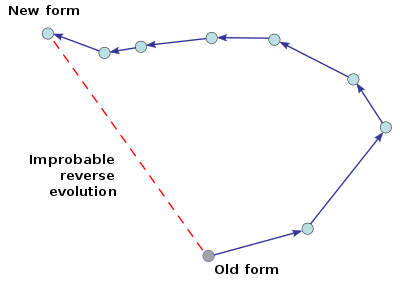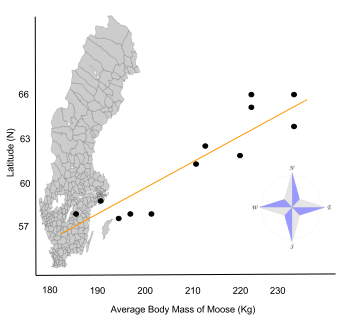Dollo's law of irreversibility
Dollo's law of irreversibility (also known as Dollo's law and Dollo's principle), proposed in 1893[1] by Belgian paleontologist Louis Dollo states that, "an organism never returns exactly to a former state, even if it finds itself placed in conditions of existence identical to those in which it has previously lived ... it always keeps some trace of the intermediate stages through which it has passed."[2]

The statement is often misinterpreted as claiming that evolution is not reversible [3], or that lost structures and organs cannot reappear in the same form by any process of devolution.[4][5] According to Richard Dawkins, the law is "really just a statement about the statistical improbability of following exactly the same evolutionary trajectory twice (or, indeed, any particular trajectory), in either direction".[6] Stephen Jay Gould suggested that irreversibility forecloses certain evolutionary pathways once broad forms have emerged: "[For example], once you adopt the ordinary body plan of a reptile, hundreds of options are forever closed, and future possibilities must unfold within the limits of inherited design."[7]
This principle is classically applied to morphology, particularly of fossils, but may also be used to describe molecular events, such as individual mutations or gene losses.
Use in phylogenetics
In maximum parsimony, Dollo parsimony refers to a model whereby a character is gained only one time and can never be regained if it is lost.[8] For example, the evolution and repeated loss of teeth in vertebrates could be well-modeled under Dollo parsimony, whereby teeth made from hydroxyapatite evolved only once at the origin of vertebrates, and were then lost multiple times, in birds, turtles, and seahorses, among others.[9]
This also applies to molecular characters, such as losses or inactivation of individual genes themselves.[10] The loss of gulonolactone oxidase, the final enzyme in the biosynthetic pathway of vitamin C, is responsible for the dietary requirement of vitamin C in humans, as well as many other animals.[11]
A molecular example
A 2009 study on the evolution of protein structure proposed a new mechanism for Dollo's law. It examined a hormone receptor that had evolved from an ancestral protein that was able to bind two hormones to a new protein that was specific for a single hormone. This change was produced by two amino acid substitutions, which prevent binding of the second hormone. However, several other changes subsequently occurred, which were selectively neutral as they did not affect hormone binding. When the authors tried to revert the protein back to its ancestral state by mutating the two "binding residues", they found the other changes had destabilised the ancestral state of the protein. They concluded that in order for this protein to evolve in reverse and regain its ability to bind two hormones, several independent neutral mutations would have to occur purely by chance with no selection pressure. As this is extremely unlikely, it may explain why evolution tends to run in one direction.[12]
Proposed exceptions to Dollo's law
Although the exact threshold for violations of Dollo's law is unclear, there are several case studies whose results dispute the validity of some interpretations. For example, many taxa of gastropods have reduced shells, and some have lost coiling of their shell altogether.[13] In Stephen Jay Gould's interpretation of Dollo's law, it would not be possible to regain a coiled shell after the coiling has been lost. Nevertheless, a few genera in the slipper snail family (Calyptraeidae) may have changed their developmental timing (heterochrony) and regained a coiled shell from a limpet-like shell.[13][14] Other proposed 'exceptions' include the wings of stick insects,[15] the larval stages of salamanders,[16][17] lost toes in lizards,[18] lost lower teeth in frogs,[19] clavicles in non-avian theropod dinosaurs,[20] and neck, pectoral region, and upper limb musculature in primates, including the lineage leading to humans.[21]
References
- Dollo, Louis (1893). "Les lois de l'évolution" (PDF). Bull. Soc. Belge Geol. Pal. Hydr. VII: 164–166.
- Gould, S. J. (1970). "Dollo on Dollo's law: irreversibility and the status of evolutionary laws". Journal of the History of Biology. 3 (2): 189–212. doi:10.1007/bf00137351. PMID 11609651.
- Alfarouk, Khalid O.; Shayoub, Mohammed E.A.; Muddathir, Abdel Khalig; Elhassan, Gamal O.; Bashir, Adil H.H. (22 July 2011). "Evolution of Tumor Metabolism might Reflect Carcinogenesis as a Reverse Evolution process (Dismantling of Multicellularity)". Cancers. 3 (3): 3002–3017. doi:10.3390/cancers3033002.
- Goldberg, Emma E.; Boris Igić (2008). "On phylogenetic tests of irreversible evolution". Evolution. 62 (11): 2727–2741. doi:10.1111/j.1558-5646.2008.00505.x. PMID 18764918.
- Collin, Rachel; Maria Pia Miglietta (2008). "Reversing opinions on Dollo's Law". Trends in Ecology & Evolution. 23 (11): 602–609. doi:10.1016/j.tree.2008.06.013. PMID 18814933.
- Dawkins, Richard (1996) [1986]. The Blind Watchmaker. W. W. Norton. ISBN 978-0-393-31570-7.
- Gould, Stephen J. (2007) [1993]. Eight little piggies. Vintage Books. ISBN 978-0-09-950744-4.
- Farris, J. (1977). "Phylogenetic Analysis Under Dollo's Law". Systematic Zoology. 26 (1): 77–88. doi:10.1093/sysbio/26.1.77.
- Lin,Q.; et al. (2016). "The seahorse genome and the evolution of its specialized morphology". Nature. 540 (7633): 395–399. doi:10.1038/nature20595. PMID 27974754.
- Rogozin, Igor B.; Wolf, Yuri I.; Babenko, Vladimir N.; Koonin, Eugene V. (2005). Dollo parsimony and the reconstruction of genome evolution. Parsimony, Phylogeny, and Genomics. pp. 190–200. doi:10.1093/acprof:oso/9780199297306.003.0011. ISBN 9780199297306.
- Yang, Hongwen (2013). "Conserved or Lost: Molecular Evolution of the Key Gene GULO in Vertebrate Vitamin C Biosynthesis". Biochemical Genetics. 51 (5–6): 413–425. doi:10.1007/s10528-013-9574-0. PMID 23404229.
- Bridgham, Jamie T.; Ortlund, Eric A.; Thornton, Joseph W. (2009). "An epistatic ratchet constrains the direction of glucocorticoid receptor evolution". Nature. 461 (7263): 515–519. doi:10.1038/nature08249. PMC 6141187. PMID 19779450.
- Collin, R.; Cipriani, R. (2003). "Dollo's law and the re-evolution of shell coiling". Proceedings of the Royal Society B. 270 (1533): 2551–2555. doi:10.1098/rspb.2003.2517. PMC 1691546. PMID 14728776.
- Pagel, M. (2004). "Limpets break Dollo's Law". Trends in Ecology & Evolution. 19 (6): 278–280. doi:10.1016/j.tree.2004.03.020. PMID 16701270.
- Whiting, MF.,S. Bradler & T. Maxwell (2003). Loss and recovery of wings in stick insects. Nature 421 264-267.
- Chippindale, P. T. and J. J. Wiens. (2005). Re-evolution of the larval stage in the Plethodontid salamander genus Desmognathus. Herpetological Review 36(2) 113.
- Marshall, C. R. (1994). "Dollo's law and the death and resurrection of genes". Proc Natl Acad Sci USA. 91 (25): 12283–7. doi:10.1073/pnas.91.25.12283. PMC 45421. PMID 7991619.
- Galis, F. (2010). "Dollo's law and the irreversibility of digit loss in Bachia". Evolution. 64 (8): 2466–76, discussion 2477–85. doi:10.1111/j.1558-5646.2010.01041.x. PMID 20500218.
- Davies, E. Frogs re-evolved lost lower teeth. BBC News. January 31, 2011. Retrieved February 9, 2011.
- Paul, Gregory S. (2002). Dinosaurs of the Air: the evolution and loss of flight in dinosaurs and birds. CJHU Press. p. 10. ISBN 978-0-8018-6763-7.
- Diogo, R.; Wood, B. (2012). "Violation of Dollo's Law: Evidence of Muscle Reversions in Primate Phylogeny and Their Implications for the Understanding of the Ontogeny, Evolution, and Anatomical Variations of Modern Humans". Evolution. 66 (10): 3267–76. doi:10.1111/j.1558-5646.2012.01621.x. PMID 23025614.
External links
- The Loom: Recoil From Dollo's Law
- Marshall, CR; Raff, EC; Raff, RA (December 1994). "Dollo's law and the death and resurrection of genes". Proc. Natl. Acad. Sci. U.S.A. 91: 12283–7. doi:10.1073/pnas.91.25.12283. PMC 45421. PMID 7991619.
